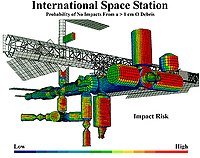
Photo from wikipedia
To the Editor, With great interest, we read the recent article by Dezube et al determining the risk factors of postoperative delirium (POD) after esophagectomy. They showed that POD was… Click to show full abstract
To the Editor, With great interest, we read the recent article by Dezube et al determining the risk factors of postoperative delirium (POD) after esophagectomy. They showed that POD was common with an incidence of about 17%, and associated with many perioperative risk factors, such as increasing age, chronic obstructive pulmonary disease, pneumonia, surgical technique, intraoperative and postoperative transfusion, sepsis, unplanned intubation, and increased length of stay. As POD has been associated with increased lengths of hospital stay, costs, morbidity, and mortality in surgical patients, their findings have potential clinical implications. However, we noted several methodological issues in this study that seemed important to avoid misinterpretation of their results. First, the details of the observed time for POD were not provided. Regarding the determination of POD, moreover, the authors described that electronic medical records for patients including perioperative notes and discharge summaries were reviewed by two different physicians. The descriptive “trigger” words used for documenting the presence of POD included: mental status change, confusion, disorientation, agitation, delirium, inappropriate behavior, inattention, hallucinations, combative. If patients had one or more episodes of acutely altered mental status changes in the context of their postoperative recovery, they were noted to have developed POD. These seem to not agree with the new recommendations for nomenclature of cognitive change associated with anesthesia and surgery‐2018. The new recommendations need to observe the POD occurred in hospital for up to 1 week after surgery or until discharge. Also, POD should meet the diagnostic criteria of the DSM‐5. In the DSM‐5, diagnostic criteria of delirium include a fluctuating disturbance in attention, awareness, and cognition that develops over a short period. Second, in this study, alone use of a univariate logistic regression analysis to identify the perioperative risk factors for POD was evidently improper. In a retrospective study, multivariable logistic regression analysis is a useful statistical method for identification of risk factors of adverse perioperative events by adjusting patients’ baseline characteristic and controlling selection biases. Actually, building a model of multivariable logistic regression analysis needs two steps: (a) The univariate logistic regression analysis is used to identify the clinical factors associated with the occurrence of POD; (b) The variables identified as significant (P < .2) in univariate analysis are subsequently included in the multivariate logistic regression analysis for identification of independent risk factors for POD. As step (b) had not been considered by Dezube et al, their results must be interpreted with great caution. Third, the power of this study is the inclusion of most perioperative variables that may affect the occurrence of POD. However, we noted that all study subjects were esophageal cancer patients, with a mean age of 64.2 years. It was unclear why the preoperative cognitive assessment was not included in patient characteristics, though preoperative cognitive impairment is a known predisposing factor for POD in patients with major surgery. Furthermore, the details of anesthetic interventions were not provided. Among drugs commonly used in anesthetic practice, opioids, sevoflurane, benzodiazepines, and anticholinergics have been implicated in the development of POD. Other than type of surgery, duration of operation and transfusion, intraoperative hypercapnia and hemodynamic instability have also been identified as the independent risk factors for POD in surgical patients. Specifically, this study did not include the data of postoperative pain and analgesic management. The available evidence indicates that for patients undergoing noncardiac surgery, an increased level of postoperative pain is a risk factor for development of POD, while effective control of postoperative pain reduces the incidence of POD. Thus, we argue that the findings of this study would be more informative, if study design had included these data. Finally, in available literature, there is not a predictive model or risk score for POD specific to patients with esophagectomy. It is strongly recommended that the authors should collect more perfect perioperoperative data from their electronic medical records, apply the right statistical methods for identification of real independent risk factors for POD and then develop a prediction model or risk score of POD specific to patients undergoing esophagectomy. We believe that such works will be very helpful for identifying high‐risk patients for POD and early implementation of proactive multifactorial interventions for high‐risk patients to reduce the occurrence of POD in this surgical population.
Journal Title: Journal of Surgical Oncology
Year Published: 2020
Link to full text (if available)
Share on Social Media: Sign Up to like & get
recommendations!